For LANL Cleanup, GAO Recommends a Facilitator to Improve Relationship between New Mexico Environment Department and DOE
![]() In a July 2023 report the federal Government Accountability Office recommended that a third-party facilitator be brought in to improve the relationship and build trust between the New Mexico Environment Department and the Department of Energy (DOE) as they try to resolve outstanding cleanup issues at the Los Alamos National Laboratory (LANL). https://www.gao.gov/products/gao-23-105665 Nuclear Waste Cleanup: DOE Needs to Address Weaknesses in Program and Contractor Management at Los Alamos, July 2023.
In a July 2023 report the federal Government Accountability Office recommended that a third-party facilitator be brought in to improve the relationship and build trust between the New Mexico Environment Department and the Department of Energy (DOE) as they try to resolve outstanding cleanup issues at the Los Alamos National Laboratory (LANL). https://www.gao.gov/products/gao-23-105665 Nuclear Waste Cleanup: DOE Needs to Address Weaknesses in Program and Contractor Management at Los Alamos, July 2023.
That recommendation was echoed by members of the New Mexico legislature at the August 21st meeting of the Radioactive and Hazardous Materials Committee in Los Alamos. https://www.nmlegis.gov/committee/Interim_Committee?CommitteeCode=RHMC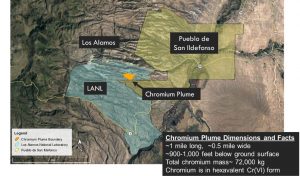
One outstanding cleanup issue, of several GAO highlighted, is whether the toxic hexavalent chromium plume located below LANL is moving deeper into the regional drinking water aquifer, as the Environment Department argues. Or whether, as DOE argues, the plume is ready for a permanent pump and treat system in which aquifer water is pumped to the surface, run through filtration to remove the chromium, and then injected back into the plume. https://www.gao.gov/products/gao-23-105665 , pp. 11-12, 17-21, 33-34 (GAO’s six recommendations), 37-38.
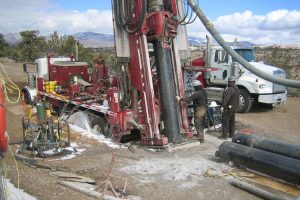 The stakes in this disagreement are high. The Environment Department says that the treated waters can no longer be injected into the plume as that pushes the toxic contamination deeper into the aquifer. Its solution is to find other locations for injection of the treated water. DOE says the treated water has to go back into the plume. DOE does not want to truck the waters to other locations across the 36-square mile LANL site.
The stakes in this disagreement are high. The Environment Department says that the treated waters can no longer be injected into the plume as that pushes the toxic contamination deeper into the aquifer. Its solution is to find other locations for injection of the treated water. DOE says the treated water has to go back into the plume. DOE does not want to truck the waters to other locations across the 36-square mile LANL site.
CCNS supports the recommendation for a third party facilitator.
We detailed our concerns in a Sunday, September 3rd Santa Fe New Mexican My View. https://www.santafenewmexican.com/opinion/my_view/to-eradicate-the-plume-use-the-same-models/article_b93f3b86-4849-11ee-b322-63fe35d4d7db.html You can read the full article below.
CCNS proposed that before the state and federal agencies meet with the facilitator, a comparison of the two differing groundwater models be done using data from the plume since 2016 when the Environment Department first issued a groundwater discharge permit. http://nuclearactive.org/lanls-toxic-hexavalent-chromium-plume-must-remain-a-priority/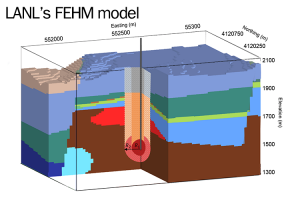
Commenters to the My View responded positively.
 Greg Corning, President of the Veterans for Peace Santa Fe Chapter, wrote, “Comparing the output of two groundwater modeling systems (with identical data entered) is an excellent idea. (“Measure twice,” as the old adage begins.)” He continued, “I can’t imagine why we would avoid doing this unless one or the other party is hoping to avoid unpleasant findings.”
Greg Corning, President of the Veterans for Peace Santa Fe Chapter, wrote, “Comparing the output of two groundwater modeling systems (with identical data entered) is an excellent idea. (“Measure twice,” as the old adage begins.)” He continued, “I can’t imagine why we would avoid doing this unless one or the other party is hoping to avoid unpleasant findings.”
Mike Johnson wrote, “This is certainly plausible and doable, and much better than negotiating with a mediator involved. But, in my experience, computer models are prone to GIGO, [or ‘garbage in, garbage out’], and an expert third party science and engineering entity should be used.”
My View: Joni Arends
To eradicate the plume, use the same models
By Joni Arends Sep 2, 2023
In response to the editorial (“Stop Stalling: Clean up chromium plume,” Our View, Aug. 24): The plume does need immediate attention and does need to be analyzed with a computer model that everyone can use. The consequences of getting the cleanup of the toxic hexavalent chromium plume wrong would be disastrous.
Concerned Citizens for Nuclear Safety urges that before the proposed negotiations between the Department of Energy and the New Mexico Environment Department take place, a comparison is made of the differing groundwater models they use.
Los Alamos National Laboratory does not use the most widely accepted and used groundwater model created by the U.S. Geological Survey, called MODFLOW. LANL uses its own groundwater model, called FEHM, which stands for Finite Element Heat and Mass Transfer Code. But to use FEHM, you have to register at fehm.lanl.gov. Today, Aug. 31, the registration links aren’t working. The USGS MODFLOW is “considered an international standard for formulating and predicting groundwater conditions and groundwater/surface water interactions.” Most water professionals use MODFLOW to protect water from contamination. It is a computer model that is publicly available without the need to register.
Our group suggests that groundwater monitoring data from 2016 forward be entered into both the U.S. Geological Survey MODFLOW hydrologic model and Los Alamos National Laboratory’s own FEHM model and compared.
Concerned Citizens for Nuclear Safety first suggested this approach as far back as 1998, when the first groundwater monitoring well was installed under LANL’s hydrogeological work plan. Over the decades, we have witnessed the long-standing resistance by LANL to use MODFLOW.
Water is too precious to put its purity at risk. The toxic hexavalent chromium plume below LANL was discovered in 2004. The big question right now is whether the injection of treated water is pushing, or smearing, the contamination deeper into the regional drinking water aquifer.
This is a big deal. To reach the drinking water aquifer where the hexavalent chromium is found, the wells must be at least 1,000 feet deep. Those wells extract, or pump, the waters to the surface, where they are run through large filters to remove the pollutants. The waters are then injected back into the aquifer to create a hydrologic barrier to keep the plume from moving. But the state Environment Department has concerns the injection is moving the existing contamination deeper into the aquifer.
In the early days of this effort, the hexavalent chromium was found in the top 50 feet of the aquifer. Now LANL says it is in the top 150 feet of the aquifer, creating an impasse between the state Environment Department and Department of Energy.
Importantly, the plume is sitting on the west side of the Española Basin Sole Source Drinking Water Aquifer. In 2008, the Environmental Protection Agency found 85% of the drinking water in the 3,000-square-mile designated area comes from wells in the aquifer. The importance of getting the cleanup right cannot be understated.
On Aug. 21, the New Mexico Legislature’s Radioactive and Hazardous Material Committee met in Los Alamos. The toxic plume was on the agenda. A suggestion was made to bring in an independent negotiator to break the impasse. This is a good idea. A complete investigation of the movement of the hexavalent chromium in the aquifer will reveal if it has spread into the Española Basin SSA. To break the impasse, a comparison of the two groundwater models using the same data is required now.
Joni Arends is a co-founder and executive director of Concerned Citizens for Nuclear Safety. She actively protects water from Los Alamos National Laboratory contamination.
- Friday, September 8th from noon to 1 pm MT –
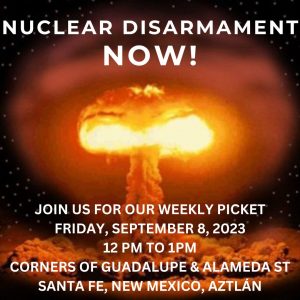 Join the weekly peaceful protest for nuclear disarmament on the corners of Alameda and Guadalupe in downtown Santa Fe with Veterans for Peace, CCNS, Nuclear Watch NM, Loretto Community, Pax Christi, Nonviolent Santa Fe, and others.
Join the weekly peaceful protest for nuclear disarmament on the corners of Alameda and Guadalupe in downtown Santa Fe with Veterans for Peace, CCNS, Nuclear Watch NM, Loretto Community, Pax Christi, Nonviolent Santa Fe, and others.
Come and visit with us about planning Defuse Nuclear War events (Sept. 24 – 30 Week of Action) and the Back from the Brink campaign. Pick up Back from the Brink materials to support work to prevent nuclear war. https://preventnuclearwar.org/
- Friday, September 22, 2023 from 5 to 7 pm MT –
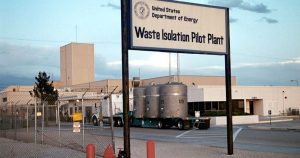 NM Environment Department hybrid public meeting to present the changes made to the draft hazardous waste permit as represented in the proposed 10-year final permit for the Waste Isolation Pilot Plant (WIPP). The public is invited to ask questions to NMED and WIPP representatives and make public comments. For more information, see the August 15, 2023 public notice. https://hwbdocuments.env.nm.gov/Waste%20Isolation%20Pilot%20Plant/230818.pdf
NM Environment Department hybrid public meeting to present the changes made to the draft hazardous waste permit as represented in the proposed 10-year final permit for the Waste Isolation Pilot Plant (WIPP). The public is invited to ask questions to NMED and WIPP representatives and make public comments. For more information, see the August 15, 2023 public notice. https://hwbdocuments.env.nm.gov/Waste%20Isolation%20Pilot%20Plant/230818.pdf
Three ways to attend the public meeting:
Carlsbad in-person location: Skeen-Whitlock Bldg., 4021 National Parks Hwy.
Santa Fe in person location: Larrazolo Auditorium, NMED Harold Runnels Bldg., 1190 St. Francis Drive (between Cordova and Alta Vista).
Remote Access on WebEx: https://www.env.nm.gov/events-calendar/?trumbaEmbed=view%3Devent%26eventid%3D167732347
Three ways to submit public comments:
NMED Public Comment Portal: https://nmed.commentinput.com/?id=G5E7C
Email to Megan.McLean@env.nm.gov
Postal Mail: Megan McLean, Acting WIPP Group Program Manager
Hazardous Waste Bureau – NM Environment Department
2905 Rodeo Park Drive East, Bldg. 1
Santa Fe, NM 87505-6303
- Sign the Tewa Women United petition
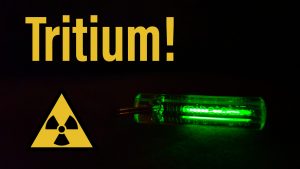 to Protect Vulnerable NM Communities: Halt Radioactive Tritium Release from LANL. LANL is proposing to vent four flanged tritium waste containers (FTWCs) by September 30, 2023 (the end of the fiscal year). https://tewawomenunited.org/2023/08/its-happening-again-petition-to-halt-lanls-planned-tritium-release
to Protect Vulnerable NM Communities: Halt Radioactive Tritium Release from LANL. LANL is proposing to vent four flanged tritium waste containers (FTWCs) by September 30, 2023 (the end of the fiscal year). https://tewawomenunited.org/2023/08/its-happening-again-petition-to-halt-lanls-planned-tritium-release
- Trinity: Legacies of Nuclear Testing –
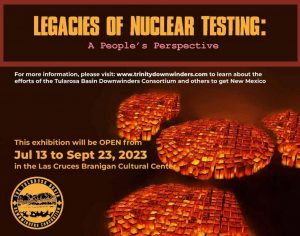 A People’s Perspective Art Exhibit at the Branigan Cultural Center, 501 N. Main Street, Las Cruces, NM. The exhibit will be up until September 23, 2023. https://www.lascruces.gov/1528/Branigan-Cultural-Center
A People’s Perspective Art Exhibit at the Branigan Cultural Center, 501 N. Main Street, Las Cruces, NM. The exhibit will be up until September 23, 2023. https://www.lascruces.gov/1528/Branigan-Cultural-Center
Tags: Department of Energy, DOE, DP-1835, FEHM, Finite Element Heat and Mass Transfer Code, GAO, GAO-23-105665, Government Accountability Office, Greg Corning, hexavalent chromium plume, LANL, Los Alamos National Laboratory, Mike Johnson, New Mexico Environment Department, New Mexico Legislative Radioactive and Hazardous Materials Committee, NMED, President of Veterans for Peace Santa Fe Chapter, Santa Fe New Mexican Our View, third-party facilitator, U.S. Geological Survey MODFLOW



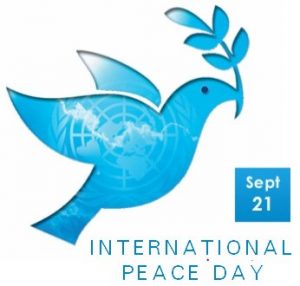













Comments
No comments so far.